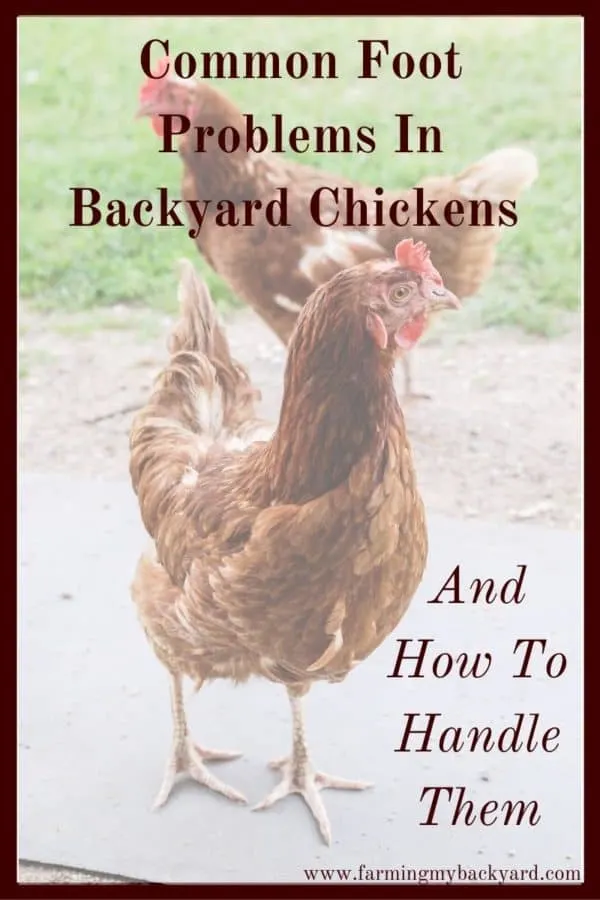Uh oh, your chicken is limping! Foot problems can be common in chickens, but what is wrong and what do you do? Here are 7 common foot problems in backyard chickens and how to take care of them.

Related Posts:
- Are Your Chickens Molting? Here’s What You Need To Know
- Can Backyard Chickens Give You Salmonella?
- How Can You Help Avoid Chicken Illnesses?
- Chicken Diseases You Need To Know About
- Deworming Chickens: Do You Need To Worry About It?
- Be Ruthless With Chicken Mites And Obnoxious Bugs
- How Do You Know If You Have A Sick Chicken?
Foot Problems In Chicks
Chicks can damage their legs if they are on too slick of a surface. This is called spraddle leg. Their legs will look splayed out, and they won’t be able to walk. Put a rubber mat down in your incubator and use bedding in your brooder. Also, hobble the legs together with vet tape so the chick learns to walk properly. For more information on how to do this, check out Backyard Chickens.
Also Vitamin B can help chicks with spraddle leg, or other muscle weaknesses be stronger. Foods that are high in B vitamins include hard boiled eggs, almonds, and spinach. If you are hatching out your own eggs, make sure the mother hens have plenty of B and D vitamins when laying.
Scaly Legs
Scaly legs are caused by mites that crawl under the scales of the feet and legs. You may notice a crust on the feet and legs, and it can be passed to other members of the flock. You can treat this by suffocating the mites. First clean the legs with soap and water, then cover their legs with Vaseline for 7 days.
Alternatively, you can treat them with Ivermectin. This is an off label use, but you can place 3-6 drops (depending on size of your bird) on the skin on the back of each bird’s neck to kill parasites. Repeat in 10 days.
Bumblefoot
Bumblefoot is a fancy chicken term for a foot infection. The best way to deal with bumblefoot is to prevent if from happening in the first place. Keep your chicken run free of anything that could puncture your birds’ feet and make sure they have good nutrition to fight off any potential issues. Also, make sure their bedding is clean and dry.
If you do notice a foot infection, your chicken’s foot will be hot and swollen. It may have a black spot or puncture wound. For a minor infection, you may be able to clear it up by soaking the bird’s leg in Nolvasan daily and treating with a topical antibiotic.
If the infection is very bad and painful for the bird many backyard chicken keepers choose to clean the wound out themselves.
First soak the chicken’s leg in Epsom salts and warm water. Then wrap your chicken firmly in a towel and place them upside down on your lap. Using sterilized tweezers or small scissors remove the cap or scab of the infection and remove as much of the pus as you can.
Rinse the wound with hydrogen peroxide and fill it with Neosporin before wrapping your bird’s foot with gauze and vet tape. Keep your birds feet very clean and dry for the next 30 days and check the wound daily for indications that infection has returned. If it does, remove as much infected material as you can. Rewrap the foot with Neosporin and fresh gauze.
Mycoplasma synoviae
If your whole flock apperas to have bumblefoot, or it just keeps coming back over and over, you may actually be dealing with mycoplasma synoviae. Your flock will need to be treated with antibiotics and all of their housing should be disinfected. You will want to work with a vet for testing and treating this without it reoccuring or spreading to other birds your bring into your flock.
Leg Injury
To prevent injuries to your birds, never grab them by the legs, or drop them. Try to make sure there are not slick areas of the coop, such as ramps into the hen house. Also make sure there is enough space in your coop and run, and that there are enough feeders and waterers for all the birds to access without fighting.
If you do have an injured bird that is limping, keep it in a smaller pen away from the flock until it has time to heal. Most minor foot problems will resolve themselves with rest. However, if it is obvious that the leg is broken, find a vet.
Frostbite
The best way to treat frostbite is to prevent it. Make sure your birds have places to go out of the snow when it is very cold. Frostbitten feet will be dark blue or black, and may even have blisters.
The first thing to do is get the bird’s feet warm, a warm water bath will work for this. If there are blisters, you can carefully drain them, cover with Neosporin and wrap the feet with gauze and vet tape. Keep your chicken separate from the rest of the flock until they heal.
Marek’s Disease
This is a neurological disorder, but it can look like a foot problem as it causes paralysis. There is a vaccine to prevent Marek’s, but there is no treatment once your bird already has it. If you are purchasing chickens from a breeder, hatchery, or feed store they most likely have already been vaccinated.
While foot problems in chickens can seem daunting, the best thing you can do is to prevent them from popping up in the first place! Keep your bird’s coop and run, clean, dry, and free of anything that could cause a puncture. Make sure your flocks gets plenty of good nutrition, and you should be able to avoid most problems.

Want To Raise Happy Chickens?
Subscribe for our newsletter and get the free email course Intro To Backyard Chickens as well as a free printable checklist to walk you through step by step!


Ellen
Tuesday 6th of February 2024
One of my hens have what looks like a ball of mud on the end of her toe. I have never see this before in my 15+ years of raising chickens. Help.
Kathryn
Wednesday 7th of February 2024
I would try soaking it or running warm water over it and see if it breaks up. If it is in fact mud that should help. My other thought would be bumblefoot.
Melissa
Wednesday 10th of November 2021
Hi, I have some chickens who have the bottom padded area of their feet are hardened. It looks like scales have formed and are building up in the area to protect the padded area. Is that bumble foot? There appears to be no infection. My thoughts were they are hurting their feet jumping down from the roost or out of the coop. How can I treat this? Thank you Melissa
Kathryn
Thursday 11th of November 2021
If they are jumping down from high distances onto hard ground that could be the problem. I would add some rungs that they can use to jump up and down and just keep an eye on it.
Tallon
Thursday 15th of July 2021
Hi, I have a hen and she has foot problems for over a week she is limping and does not walk very often anymore. It started on the 4th when she got out of the yard and we thought she got attack by a coyote or wild dog because when we found her she had a wing injury and what looked like a bite. anyway I was wondering if I should take her to a poultry vet or let her get better on her own. Thank you!
Kathryn
Sunday 18th of July 2021
If you have a poultry vet, that's a great option. If not, give her a good look over and see if you can find any injury or infection.
Diane
Tuesday 21st of July 2020
I wish I could print this for future reference....I keep a binder on useful articles about my chickens!
Kathryn
Monday 27th of July 2020
Thanks for the suggestion Diane! I've added a printable cheat sheet version to my etsy shop and I will email you a complimentary copy.